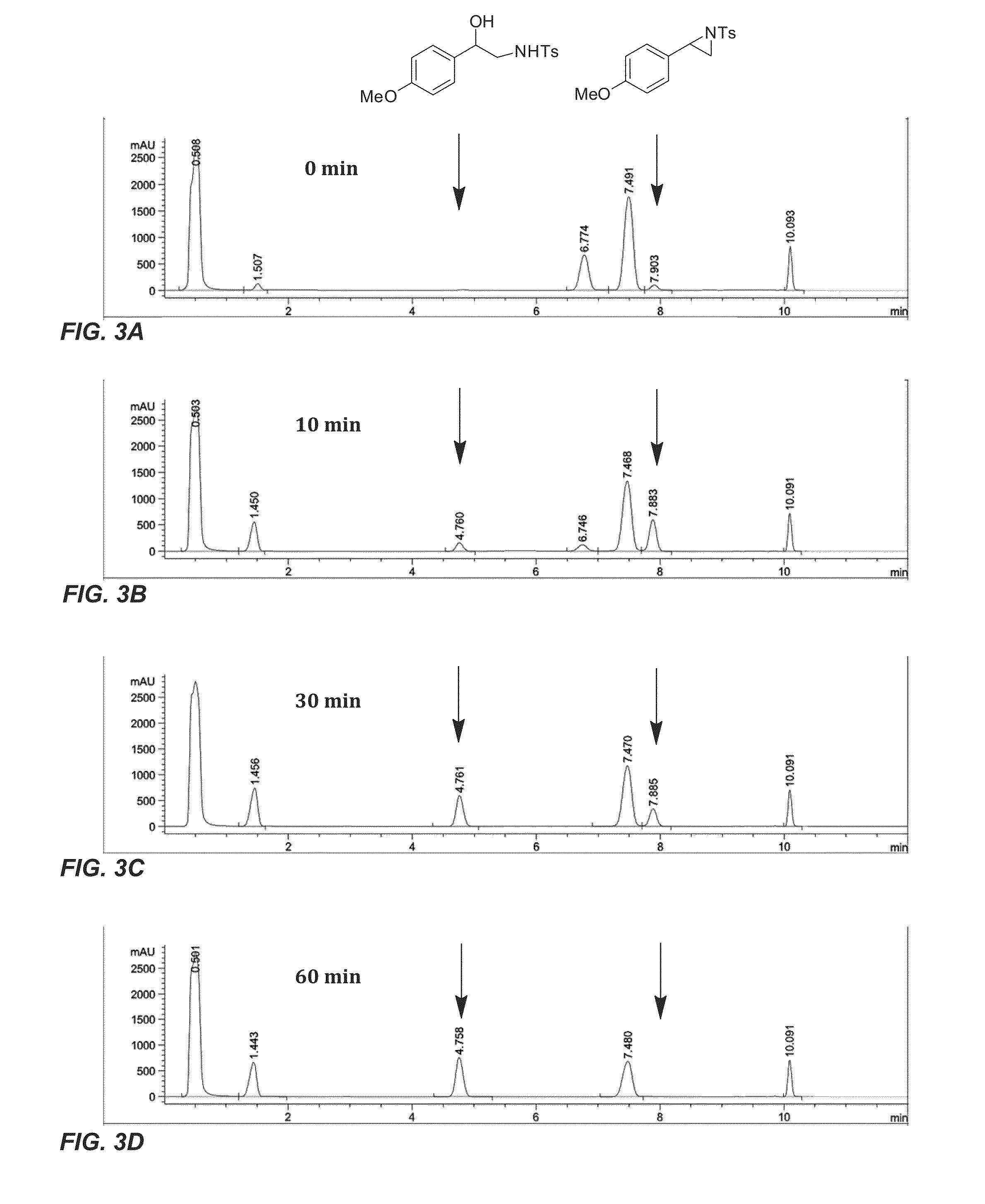Enzyme-catalyzed enantioselective aziridination of olefins
- Summary
- Abstract
- Description
- Claims
- Application Information
AI Technical Summary
Benefits of technology
Problems solved by technology
Method used
Image
Examples
Example
Example 1
Aziridination Activity of Cytochrome P450 Variants and Other Heme Proteins
[0186]This example illustrates the aziridination activity of known cytochrome P450 variants and other heme containing enzymes.
[0187]Previous studies have shown that cytochrome P450 and mutants thereof can catalyze a wide variety of chemical reactions including cyclopropanation, sulfinde imidation, and C—H amination. In order to assess the potential of a cytochrome P450 or a mutant thereof to catalyze an aziridination reaction, engineered variants of cytochrome P450BM3 and P411BM3-CIS-T438S, previously found to be effective for intramolecular C—H amination and sulfide imidation, were tested for aziridination activity. Cytochrome P450BM3 is a naturally occurring enzyme found in the soil bacterium bacillus megaterium, and P411BM3-CIS-T438S is a 14 mutation variant of P450BM3 (see Table 2 for mutations from wild-type P450BM3). P411BM3-CIS-T438S is called a “P411” due to the change in the characteristic CO...
Example
Example 2
Optimizing Cytochrome P450 Aziridination Activity
[0192]This example illustrates bacterial cytochrome P450s that are engineered to catalyze highly stereoselective nitrene transfers to olefin substrates to make aziridines.
[0193]The P-I263F enzyme identified in the initial studies of enzyme catalyzed aziridination provided enough aziridine product in whole-cell reactions to allow for screening variants in 96-well plate format. Thus, further improvement of aziridination productivity was sought by mutagenesis of this enzyme and screening for aziridination productivity. Site-saturation mutagenesis (SSM) libraries were created at several active site positions that were previously shown to influence productivity and enantioselectivity in other non-natural reactions (A78, L181, T438, A328). Screening of these single SSM libraries for aziridination of 4-methylstyrene (3) identified P-I263F-A328V, with slightly improved yield and substantially improved % ee (96% eeS; entry 4, Table 5)...
Example
Example 3
Productivity and Enantioselectivity of Select Cytochrome P450 Enzymes
[0195]This example illustrates the aziridination productivity and enantioselectivity of P-I263F-A328V-L437V when reacted with different substrates. This example also illustrates the aziridination productivity and enantioselectivity using enzyme variant P411BM3 H2-A-10 I263F.
[0196]Having obtained a variant capable of high productivity and enantioselectivity for the aziridination of 4-methylstyrene (3), whole-cell reactions with different substituted styrene substrates were investigated (Table 6). No correlation between the electronics of the aryl substituent and the productivity of the enzyme were observed. In general, the evolved enzyme was more productive with styrenes substituted at the 4-position, though the highest productivity was observed with styrene itself. The evolved enzyme provided 600 catalytic turnovers for the formation of aziridine 6, corresponding to a 70% yield of 6 (entry 3 in Table 6). W...
PUM
| Property | Measurement | Unit |
|---|---|---|
| Fraction | aaaaa | aaaaa |
| Fraction | aaaaa | aaaaa |
| Fraction | aaaaa | aaaaa |
Abstract
Description
Claims
Application Information
 Login to View More
Login to View More - R&D
- Intellectual Property
- Life Sciences
- Materials
- Tech Scout
- Unparalleled Data Quality
- Higher Quality Content
- 60% Fewer Hallucinations
Browse by: Latest US Patents, China's latest patents, Technical Efficacy Thesaurus, Application Domain, Technology Topic, Popular Technical Reports.
© 2025 PatSnap. All rights reserved.Legal|Privacy policy|Modern Slavery Act Transparency Statement|Sitemap|About US| Contact US: help@patsnap.com



